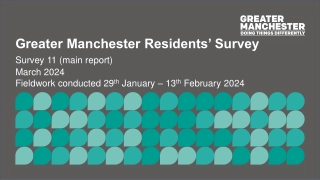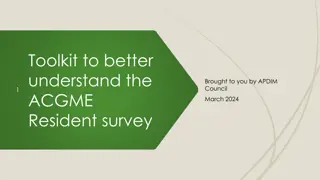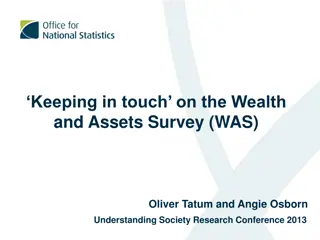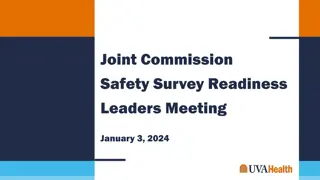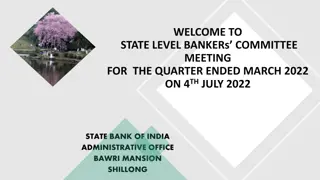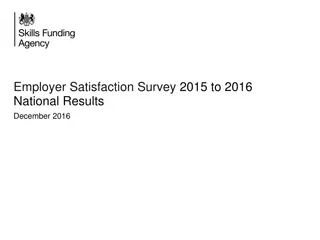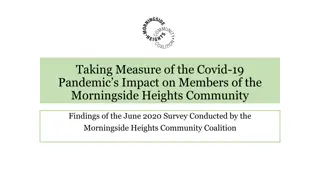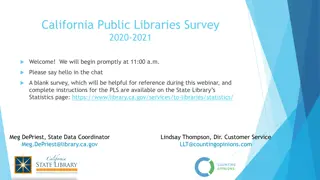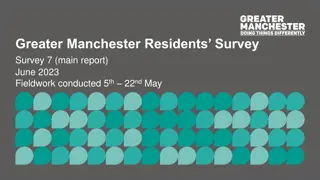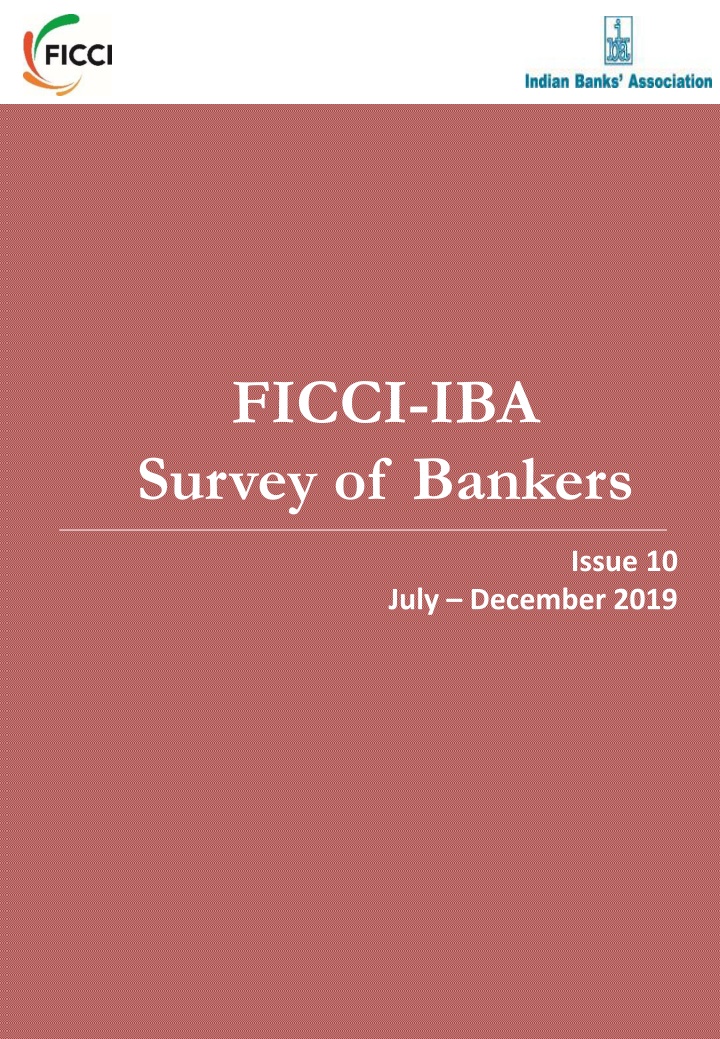
Bankers' Survey Findings Summary July-December 2019
Tenth round of FICCI-IBA survey highlights bankers' views on economy, MSME lending challenges, NPA trends, and restructuring requests in various sectors for July-December 2019 period.
Download Presentation

Please find below an Image/Link to download the presentation.
The content on the website is provided AS IS for your information and personal use only. It may not be sold, licensed, or shared on other websites without obtaining consent from the author. If you encounter any issues during the download, it is possible that the publisher has removed the file from their server.
You are allowed to download the files provided on this website for personal or commercial use, subject to the condition that they are used lawfully. All files are the property of their respective owners.
The content on the website is provided AS IS for your information and personal use only. It may not be sold, licensed, or shared on other websites without obtaining consent from the author.
E N D
Presentation Transcript
Issue 1 January June 2015 FICCI-IBA Survey of Bankers Issue 10 July December 2019
Survey Findings Summary The tenth round of the FICCI-IBA survey was carried out for the period July to December 2019. A total of 18 banks including public sector, private sector and foreign banks participated in the survey. These banks together represent about 50% of the banking industry, as classified by asset size. Keeping in view the ongoing economic slowdown, Bankers were asked about their views on the steps that the government should take to help economy come out of the current situation. Banks are of the view that rural distress should be addressed through laying emphasis on rural infrastructure development and stimulating demand by increasing the pace of fund transfers under PM-Kisan and Mahatma Gandhi National Rural Employment Guarantee Act (MGNREGA) scheme. Some of the respondent banks also suggested that the government should undertake structural land and labour reforms, while taking measures to increase job creation in the country. A large number of participating bankers have mentioned that addressing the taxation issues by launching GST 2.0 regime and bringing a direct tax code should be the top priority of the government at this moment. The participating bankers also shared their views on MSME lending challenges in India and the measures that banks can take to increase lending to this important segment of the society which contributes nearly 45% of the manufacturing output and provides employment to over 100 million people. Some of the challenges that the responding banks shared about MSME lending include improper maintenance of financial statements, high cost of processing MSME loans relative to their loan size, lengthy loan processing exercise, lack of technical understanding and limited affordability of digital payment platforms that restricts the use of digital payment options by MSMEs, and entrepreneurial risks faced by MSMEs. The responding banks have suggested several ways to increase the flow of funds to MSMEs such as capacity building of MSMEs through various training programs, development of an online platform to help banks accelerate the SME lending process, development of creative ways of credit assessment like using psychometric testing, cash flow estimates or Qualitative Credit Assessment (QCA) and keeping NPA of this sector under check through measures like reclassification of IRAC norms for MSMEs, proper due diligence, regular follow up, strict monitoring of the end-use of funds, etc. In the current round of the Bankers survey, less proportion of responding banks have reported a decline in the level of NPAs. As compared to the first half of 2019 in which nearly 52% of the respondents had reported a decline in the NPA levels, the proportion of respondent banks citing a reduction in NPAs in the current round of survey has reduced to 39%. The proportion of respondent banks reporting a rise in the NPA levels on the other hand has shown slight increase to 28% as against 26% in the preceding survey. Amongst the key sectors with high level of NPAs such as Infrastructure, Metals and Iron & Steel, Engineering Goods and Textiles, higher proportion of respondent bankers have indicated high levels of NPAs in these sectors. For instance, while about 73% and 55% of the respondents mentioned Infrastructure and Metals, Iron & Steel as sectors with high level of NPAs respectively in the last 2
Survey Findings Summary survey round, the proportion of respondents saying so have increased to 93% and 60% in the current round of survey. Amongst the respondents stating infrastructure as high NPA sector, about 36% of these respondents have reported an increase in NPA in this sector during July- December, 2019 period. Likewise, 17% of the respondents citing Engineering goods as high NPA sector have mentioned an increase in NPA levels in this sector. Moreover, in the current round of survey, 39% of the respondent bankers have cited an increase in the requests for restructuring of advances as against 29% in the previous round. While 33% have stated a fall in the number of such requests and 28% have reported no change in the number of such requests as compared to 19% and 52% respectively in the previous round. In 2019, RBI has reduced the repo rate by 135 bps through five consecutive rate cuts from 6.5% to 5.15%. The findings of the latest round of survey shows that about 94% of the responding banks have decreased the MCLR during this period. About 11% of the respondents reduced the MCLR by more than 50 bps, 28% of the respondents reported having reduced the MCLR by 40-50 bps. 17% of the respondents reduced MCLR by 30-40 bps, another 17% reduced it by 20-30 bps and 22% reduced it by 0-20 bps. It is pertinent to note that External Benchmark Lending Rate ( EBLR) has become effective from 1st October, 2019 for certain categories like retail loans and loans to micro and small industries. In case of term deposits above one year, 67% of the responding banks have decreased interest rates by upto 50 bps while 28% have decreased the rates by more than 50 bps. For term deposits below one year, majority respondents (67%) have reduced the interest rates, while 28% have kept the interest rate unchanged. With a view to allow faster transmission of rate cuts to consumers, the RBI has made it mandatory for banks to link all retail and SME loans to an external benchmark effective from October 1, 2019. Most of the banks have adopted repo rate as the EBLR. During October-December 2019, the WALRs of domestic (public and private sector) banks on fresh rupee loans declined by 18 bps for housing loans, 87 bps for vehicle loans and 23 bps for loans to micro, small and medium enterprises (MSMEs). Overall the transmission through EBLR is encouraging. In the current round of survey, Bankers were asked to share their views about the response of customers regarding migrating to EBLR from MCLR and the measures that the banks have taken to enable this shift. Majority of banks reported positive response of borrowers towards shift to EBLR as they find EBLR linked rate of interest more attractive. Banks have taken wide scale publicity measures to create awareness about the EBLR. Banks are also offering easier switching process for conversion of loans from MCLR to EBLR. In terms of the composition of loans and advances, the share of corporate loans of banks has increased to 58% as against 55% in the last round. Consecutively, the share of retail loans has reduced to 42% as against 45% in the preceding round. Bankers were also asked about their views and experience on the co-lending model of lending between banks and NBFCs permitted by RBI. Majority of the respondent banks reported that the model is in early stages of implementation and hence has not yet led to any significant improvement in the credit flows to the priority sector. Some responding banks also reported that there are certain challenges with the model which has restricted its take off at the desired level. For instance banks follow concept of guarantor in MSME loans whereas NBFCs prefer concept of co- borrower, difference in CGTMSE coverage norms of banks and NBFCs, different criteria of loan assessment followed by banks and NBFCs and difference in method of interest calculation of banks 3
Change in Credit Standards In the current round of survey, 41% of respondent banks reported tightening of credit standards for large enterprises as against 48% in the last round and 64% in the survey round previous to that indicating continuous improvement in funding. 59% of the respondents reported the credit standards having remained same as against 48% of the banks reporting the same in the last round. None of the respondent banks have eased the standards for large enterprises in the current round. For SMEs, as against 17% of the respondent banks reporting easing of credit standards in the last round, 44% of the respondents have reported the same in the current survey round, and the same proportion of respondents (44%) have also reported no change in credit standards. Both Government and RBI have taken measures to encourage banks to lend more to MSMEs. Credit standards for large enterprises (% respondents) Credit standards for SMEs (% respondents) 100% 100% 5 5 5 10 14 16 17 36 80% 80% 23 44 48 59 60 67 60% 60% 68 68 78 40% 40% 44 67 64 48 20% 20% 41 35 28 18 16 11 4 0% 0% Round VI H2 2017 Round VII H1 2018 Round VIII H2 2018 Round IX H1 2019 Round X H2 2019 (Current) Tightened Round VI H2 2017 Round VII H1 2018 Round VIII H2 2018 Round IX H1 2019 Round X H2 2019 (Current) Eased Tightened Remain Same Eased Remain Same Out of the respondents reporting a tightening in credit standards for large enterprises, 89% have cited a rise in NPAs, 67% cited expectations of weak economic growth, 44% cited higher sector-specific risk and 11% cited increase in cost of funds as factors for doing so. All the above cited reasons have showed an increase in the number of responses. None of the respondents cited increased competition as a reason behind the tightening of credit standards as against 8% having reported it in the previous round. Factors behind tightening of credit standards Rise in NPAs/ Risk of NPAs 89 Expectations of weak economic growth 67 Higher sector-specific risk 44 Increase in cost of funds 11.1 (% respondents tightening credit standards) 4
Movement in Marginal Cost of Lending Rates (MCLR) In 2019, RBI has cut the repo rate five times, lowering it by overall 135 bps. As per our latest round of survey, about 94% of the responding banks have reported a decrease in the MCLR during this period. About 22%, 17%, 17%, 28%, 11% of the respondent banks decreased the MCLR by 0-20 bps, 20-30 bps, 30-40 bps, 40-50 bps and more than 50 bps respectively. None of the respondent banks reported any increase in the MCLR. All the respondent public and private banks have reduced their MCLR whereas 75% of the foreign banks have reduced their MCLR while 25% have reported no change. With the introduction of External Benchmark Lending Rate ( EBLR), banks have started offering loans linked to repo rate, thus offering rates lower than MCLR. Bank Wise Change in MCLR Overall Change in MCLR No change 120% 5.6 Decreased 0-20 bps 11.1 100% 100% 100% Decreased 20-30 bps Decreased 30-40 bps Decreased 40-50 bps Decreased more than 50 bps 22.2 75% 80% Increase 27.8 60% Decrease 16.7 40% 25% No Change 16.7 20% 0% (% respondents) (% respondents) Public Private Foreign For term deposits below one year, 28% respondents did not change their term deposit rates, while 39% decreased it by upto 50 bps, while 28% decreased it by more than 50 bps. 6% of the respondents reported having increased the term deposit rate upto 50 bps. In case of term deposits above one year, none of the respondents reported any increase in term deposit rate. 67% of the responding banks decreased the rates by upto 50 bps, and 28% decreased it by more than 50 bps. Further, 6% of respondents maintained the status quo and did not change the rates of their term deposits above one year. Change in Term Deposit Rate - One Year & above Change in Term Deposit Rate - Below One year Increased upto 50 bps No change No change 28 28 39 Decreased upto 50 bps 6 Decreased upto 50 bps Decreased more than 50 bps 6 67 Decreased more than 50 bps 28 (% respondents) (% respondents) 5
Changes in Current Account and Savings Account Deposits Of all the respondents, 61% reported an increase in share of CASA deposits during the period July-Dec 2019 with 56% reporting a moderate increase and 5% reporting substantial increase. However, this is lower than the previous round of survey, wherein 70% of the respondent banks had reported a rise in share of CASA deposits. Since the growth in the aggregate deposit with the banks has shown deceleration, this has affected the overall deposit mobilisation. When compared across bank types, 60% public sector bank respondents experienced a rise in share of CASA deposits while 75% of private sector bank respondents and 50% foreign bank respondents reporting the same. Change in share of CASA deposits to total deposits Bank-wise change in share of CASA deposits (%) 75% 80% Increased substantially 22% 60% 17% 60% Increase 50% 50% Increased moderately 5% 40% Decrease 30% 25% No change No Change 20% 10% Decreased moderately 56% 0% Public Private Foreign (% respondents) (% respondents by type of banks) Composition of Funds Portfolio The composition of the respondent banks portfolio in this round of the survey has largely remained same as compared to that of the last round. Loans and advances comprised of about 63% of investments of the respondent banks as compared to 65% in the previous round, while the remaining about 37% constituted of SLR and non-SLR investment. The ratio of investment between SLR and non-SLR stood at 78:22 as compared to 82:18 in the previous round. Banks Portfolio : Loans and Investments 78% 63% 37% 22% Loans and Advances SLR Non-SLR 6
Composition of loans and advances In the current round of the survey, the ratio of corporate loans and retail loans in the total loans and advances has slightly changed to 58:42 as against 55:45 in the immediately preceding survey period. Composition of loans and advances Retail 42% Corporate 58% (% respondents) Infrastructure, Auto and auto components, Metals, Iron and steel, Cement, Real Estate, Chemicals, Wood & products, Beverages & Tobacco and Food Processing are witnessing a rise in long term credit according to the survey respondents. Focused stimulus given by the Government could have helped to increase the credit flow to these sectors. Sectors witnessing increase in long term loans Infrastructure (power, road, telecom, etc) 53 Auto and auto components 29 Metals, Iron & Steel 29 Cement 29 Real estate 24 Chemicals (excl pharma) 24 Wood & products 24 Beverages & tobacco 24 Food processing 18 (% respondents) 7
State of NPAs and Stressed Assets As compared to the first half of 2019 in which nearly 52% of the respondents had reported a decline in the NPA levels, the proportion of respondent banks citing a reduction in NPAs in the current round of survey has reduced to 39%. The proportion of respondent banks reporting a rise in the NPA levels has slightly increased to 28% as against 26% in the preceding survey. About 60% of participating Public sector banks have cited a reduction in NPA levels and about 30% have cited an increase. In case of participating Private sector banks, 25% have cited a decrease and 50% have stated an increase in NPA levels over the last six months. The level of NPAs has remained same for the foreign banks. Change in the level of NPAs Bank Wise Increase/Decrease in NPAs 120% 100% 100% 33% 80% Increased Increased 60% 60% 50% Decreased Decreased 28% No change 40% 30% No Change 25% 25% 39% 20% 10% 0% Public Private Foreign (% respondents) (% respondents) In the current round of survey, 39% of the respondent banks have cited an increase in the requests for restructuring of advances. While 33% have stated a fall in number of such requests and 28% have reported no change in the number of such requests. Requests for Restructuring of Advances 28% Increased Decreased 33% No change 39% (% respondents) 8
Key Sectors with High Level of NPAs According to survey respondents, major sectors with high levels of NPAs include Infrastructure, Metals and Iron & Steel, Engineering Goods and Textiles. Other sectors with high NPAs include Food processing , Auto & Auto components and Chemicals. Key sectors with high levels of NPAs Infrastructure (power, road, telecom, etc) 93.3 Metals, Iron & Steel 60.0 Engineering goods 40.0 Textiles 33.3 Food processing 20.0 Auto and auto components 20.0 Chemicals (excl pharma) 20.0 Gems & jewellery 6.7 Petroleum, coal & fuel products 6.7 Electronics 6.7 (% respondents) Trend in NPAs in key sectors While about 93% of the respondents have cited infrastructure as the key sector with NPAs, about 36% of these respondents have reported an increase in NPAs from the sector during the last six months and 57% of them have reported a reduction in NPAs of the sector over the six-month period between July and December 2019. All the respondents citing Metals, Iron and Steel sector with high NPAs, have indicated a reduction in NPA levels over the six-month period between July and December 2019. About 40% of the respondents have indicated engineering goods as a key sector with high level of NPAs, with 67% of them reporting a reduction in the NPA level in the sector from July to December 2019. About 33% of respondents cited textiles to be a sector having high level of NPA. About 80% of these respondents have reported an increase in NPA levels in the textiles sector over the period under review. 9
Expectations and Outlook on Credit The expected pattern of credit standards has largely remained same for large enterprises while it has changed for SMEs. For the period Jan -June 20, 82% respondents expect credit standards for large enterprises to remain same while only 11% respondents expect credit standards for SMEs to remain the same. 6% respondents expect further tightening of credit standards for large enterprises and 33% respondents expect tightening of credit standards for SME units. However, 56% of respondents expect credit standards for SMEs to ease in the next six months. Credit standards for SMEs Credit standards for large enterprises Expected to tighten Expected to tighten 56% 12% Expected to remain same Expected to remain same 6% 82% Expected to ease Expected to ease 11% 33% (% respondents) (% respondents) 61% respondents stated Infrastructure as an important sector for credit growth. Other key sectors indicated to see rise in credit are Cement, Metals, Iron & Steel, Construction, Auto and auto components, Renewable energy, Pharmaceuticals etc. Sectors expected to see rise in long term credit Infrastructure (power, road, telecom, etc) 61 Cement 22 Metals, Iron & Steel 22 Construction 22 Auto and auto components 22 Renewable energy 22 Pharmaceuticals 22 Others 17 Food processing 17 Real estate 17 Petroleum, coal & fuel products 17 Chemicals (excl pharma) 11 Education & Health 11 Telecom 11 FMCG 11 MSME 11 Textiles 6 Mining & quarrying 6 Retail trade /IT/e-commerce 6 Hotels & restaraunts 6 Wood & products 6 10 (% respondents)
Views on the steps to be taken by the Government for economic revival Bankers were asked about their views on the steps that government should take to help economy come out of the bleak situation Majority of respondent banks believed that addressing the taxation issues should be the top priority of the government. This should involve implementing GST 2.0 with further simplification of GST , reduction of GST slab rates, a robust GST monitoring infrastructure to ensure enhanced GST collections. This should be accompanied by implementation of a direct tax code with reduction in the income tax slabs to spur the slowing demand. To address rural distress by laying greater emphasis on rural infrastructure. To spur rural demand by expeditious disbursal of PM-Kisan and MGNREGA. funds. Views on key steps to help the economy come out of the bleak situation Some banks suggested that government should try to contain the fiscal deficit by ensuring enhanced revenue collection by curbing input tax credit frauds and fast track government disinvestment drive. The govt needs to do a balancing act in respect to expenditures like subsidies. A few banks also suggested that structural land and labour reforms should be undertaken. The land reforms should include implementing Unique Identity Numbers (UIDs) for land. Sector-specific measures need to be undertaken especially in telecom, real estate, power, textiles. Government should take measures to increase job creation along with laying a special emphasis on upskilling programs for displaced workers. 11
Views on MSME Lending Bankers were asked about their views on MSME lending challenges in India and the measures that banks can take to increase lending to the MSME sector while keeping NPAs under check Lack of financial literacy/planning and proper maintenance of financial records coupled with lack of transparency makes underwriting process difficult for banks Lack of accessibility of timely and adequate finance, cash flow mismatch, delay in payment by large corporates creating liquidity crunch often results in diversion of working capital funds to fixed assets by MSMEs, leading to deterioration of financial parameters Views on MSME lending challenges in India Low capital and low asset base, high cost of processing of loans of MSMEs relative to their loan size and long time taken in loan processing Lack of technical understanding and limited affordability of digital payments platforms, restricts the use of digital payment options. This makes servicing of such customers difficult and costly for banks. MSMEs face entrepreneurial risk arising due to inadequate market research, adoption of outdated technology, and lack of marketing skills, making them more vulnerable to market shocks and leading to rising delinquencies/ NPAs, and therefore making MSME lending riskier for banks Capacity building of the MSME borrowers through various training programs is required. Banks can extend help by providing value-added services, mentorship, guidance and support system. Bank s credit counsellors can assist borrowers in preparing their project reports and also help banks make better informed credit decisions. Digitalization with the introduction of online loan application, automated loan approval process and creation of an online platform can help banks accelerate the SME lending process. Online platforms like psbloansin59minutes.com should be extended to new entrants as well. Suggestion on measures to increase MSME lending Innovative ways of managing risks can be adopted by developing creative ways of credit assessment like using psychometric testing, cash flow estimates or Qualitative Credit Assessment (QCA). Focus should be on Cash flow-based lending instead of Balance sheet-based lending wherein loan requirement is based on actual revenue generation and capacity to repay. Risk Weighted Asset (RWA) requirement can be relaxed. To keep NPA under check, measures like reclassification of IRAC norms for MSMEs, proper due diligence, regular follow up, strict monitoring of the end-use of funds lent to MSME by conducting periodical visits to the units financed under MSME can be adopted. 12
Views on migration to EBLR from MCLR Bankers were asked about the response of customers to migrate to EBLR from MCLR and the measures banks adopted to encourage the shift from MCLR to EBLR Majority of banks reported positive response of borrowers towards shift to EBLR as they find EBLR linked rate of interest more attractive. EBLR also offers increased customer understanding than MCLR and setting EBLR has made tracking of loan pricing easier for borrowers. Response of customers to migrate to EBLR from MCLR Some banks also reported that customers are adopting cautious approach and observing the movement of repo rate closely for making decisions regarding switchover. Some banks also feel that customer response in regard to migration to EBLR can be assessed only when there will be a change in repo rate which has remained constant since October 2019. For the last one year, repo rate was coming down. But when the cycle changes, and repo moves upwards, then only the real picture of customer acceptance can be gauged. Wide scale publicity has been made by banks to create awareness about the EBLR by sending letters, emails, text messages, making phone calls and educating the walk-in customers. Banks have also issued guidelines for the switchover and given necessary directions advising all bank branches to inform their borrowers regarding switching from MCLR to EBLR. Banks have updated their public website informing the customers about the adoption of Repo Rate Linked External Benchmark and have provided the option to customers to convert to Repo Linked Lending Rate ( RLLR) from other internal benchmarks on the bank portals. Measures adopted to encourage shift from MCLR to EBLR The customer interface channels (Branches, Relationship Managers, and Phone Banking) have also been trained and apprised of the details of RLLR and the process to convert to RLLR from other benchmarks. Majority of banks either charged nominal conversion fees or no conversion fees for wider adoption of EBLR. Banks have introduced easier switching process for conversion of loans from MCLR to EBLR. 13
Views on co-lending model between Banks and NBFCs Bankers were asked about their views and experience on the co-lending model of lending between banks and NBFCs permitted by RBI, the impact of this on flow of credit to the priority sector Majority of the respondent banks reported that co-lending model is in early stages of implementation and hence has not yet led to any significant improvement in the credit flows to the priority sector Many banks have signed MoUs with NBFCs to undertake co-lending and are in the process of building automated credit model for onboarding customers, disbursement of loans and monitoring. Some respondent banks are of the opinion that co-lending model provides attractive opportunity for banks to originate priority sector portfolios consistent with their risk appetite while benefitting from the NBFCs sourcing and collection expertise. The respondents expect the new model to boost credit flow to priority sector in future. However there are certain challenges with the co-lending model due to which it is not taking off at desired level. For instance banks follow concept of guarantor in MSME loans whereas NBFCs prefer concept of co-borrower, difference in CGTMSE coverage norms of banks and NBFCs, different criteria of loan assessment followed by banks and NBFCs and difference in method of interest calculation of banks and NBFCs, and integration of systems of both the bank and NBFCs 14
Respondents Profile Eighteen Banks responded to the survey, representing a mix of public sector, private sector and foreign banks. Together, these banks constitute about 50% of the total banking asset size. Expectations are for the period January to June 2020. Profile of respondent banks (%) Respondents Profile 22% 22% 56% Private Public Foreign 15

